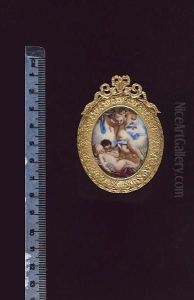Charles Glardon Paintings
Charles Glardon was a Swiss artist, born on December 5, 1871, in Vallorbe, Switzerland. He was primarily known for his work as a medalist, which is an artist who designs medals, plaquettes, badges, coins, and similar small works in relief in metal. While Glardon may not be as widely recognized as some of his contemporaries, his contributions to the field of medal-making and his artistic skills were significant during his time.
Glardon's artistic journey began in his home country, but he also spent time in Paris, which was the epicenter of the art world in the late 19th and early 20th centuries. There, he was exposed to a variety of artistic movements and styles, which influenced his own work. He was skilled in engraving and had a keen eye for detail, which is essential in the creation of medals and plaquettes. His works often featured portraits, historical events, and allegorical figures, capturing a narrative in a compact and enduring form.
Throughout his career, Charles Glardon received commissions from various institutions and individuals, which allowed him to create a diverse body of work. His medals are characterized by a blend of classical elegance and a more modern sensibility, indicative of the transitional period in which he lived and worked. He was part of the artistic milieu that bridged the gap between traditional craftsmanship and the emerging modernist aesthetic.
Glardon's work was recognized and appreciated during his lifetime. He participated in exhibitions and his medals were collected by both private collectors and institutions. Despite the relatively niche field in which he operated, his contributions to medal-making have been noted by numismatists (those who study coins and medals) and art historians alike.
Charles Glardon passed away on June 23, 1946, leaving behind a legacy as a skilled medalist whose work captured the spirit of his era. His medals continue to be appreciated by collectors and are studied by those with an interest in the art form. While he may not have achieved the fame of some of his contemporaries, his work remains a testament to the artistry and craftsmanship of medal-making in the early 20th century.
